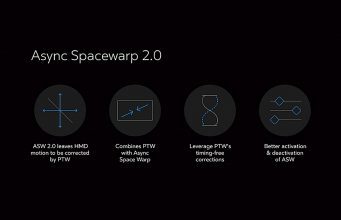
Oculus today released ASW 2.0, an upgrade to the company’s ‘Asynchronous Spacewarp’ technology which is designed to smooth out the visuals inside the headset to compensate for performance fluctuations and to keep latency low for a comfortable experience.
Oculus today announced the release of ASW 2.0 on PC for the Rift. ASW combines both ‘Timewarp’, which reduces latency, and ‘Spacewarp’, which smooths frame motion in cases where an application can’t maintain a steady 90 FPS to meet the Rift’s 90Hz display—and even enables lower-end hardware to run VR applications at 45 FPS indefinitely, while smoothing motion between frames to maintain acceptable visual performance.
Timewarp (also called reprojection) samples the position of the headset at the very last moment, after the latest frame has been rendered, and ‘warps’ the frame to better match the motion of the user’s head just before the frame is sent to the headset’s diaplay. This significantly reduces perceived latency; Timewarp and similar techniques have become essential to hitting a critical latency threshold (commonly cited at 20ms) to maintain VR comfort for most users.
In ASW 1.0, Timewarp could only be applied to headset rotation, while any positional movement was left untouched. One of ASW 2.0’s big upgrades is that Timewarp can now also act on position, which means reduced positional latency too. Positional Timewarp is achieved by leveraging depth information from a VR application which allows the frame to be correctly warped at the last second to account for positional movement.
Oculus says that ASW 2.0 is also better at handling performance fluctuations than ASW 1.0.
In the original implementation, ASW 1.0 works by reducing an application’s framerate to 45 FPS, and then interpolating between frames to maintain smooth motion despite the app running at half of the normal 90 FPS. This aids applications which sometimes fail to maintain 90 FPS—by maintaining a smooth view inside the headset to keep users comfortable—and also allows lower-end hardware to run VR applications at 45 FPS indefinitely, reducing the hardware requirements for the Rift (which Oculus refers to as ‘Minimum Specs’ vs. the ‘Recommended Specs’ which target continuous 90 FPS performance).
Oculus says that while ASW 1.0 performs well as long as an application can maintain 45 FPS, it can’t maintain smooth motion in cases where framerate drops even further.
With the new version, however, Oculus says that “even at [less than 45 FPS], ASW 2.0 can maintain an acceptable view in VR, as [Positional Timewarp’s] depth-based reprojection works more accurately for lower frame rates than ASW 1.0 extrapolation.”
Another benefit to incorporating depth information into ASW 2.0 is the accuracy of the interpolated frames.
ASW 1.0 only has the ‘flat’ frame to work with, and has to guess what the next frame should look like based on the pixels of the prior frames. Similar to video compression artifacts, visible errors are sometimes made when the system doesn’t correctly interpret the context of the frame.
By incorporating depth information into the calculations, ASW 2.0 has greater context to estimate how parts of the scene should move in the interpolated frame, which reduces visible artifacts, especially in challenging cases like high contrast patterns. Oculus illustrates the differences here:
In the video above you can see how ASW 1.0 is fooled into thinking that some parts of the black lines should move more than other parts. Understanding the depth of the scene allows ASW 2.0 to realize that the black and white lines are actually part of the same plane and should move together; the result is nearly flawless.
– – — – –
It isn’t clear at this point if ASW 2.0 was released to the main branch of the Oculus software or if it is still part of the Public Test Channel (which will eventually go live for all users at a later date). We’ve reached out to Oculus for confirmation.
Not all applications will work with ASW 2.0 right out of the box, but many will. Oculus says that “most Rift apps on the Oculus Store built on Unreal Engine 4 and Unity already provide the depth information required to make ASW 2.0 work,” but those that don’t will need to be updated to take advantage of the functionality, otherwise they will fall back to ASW 1.0.
Generally speaking, applications which have been made to work correctly with the Oculus Dash interface (such that the app is seen in the background when Dash is called forth) are already built correctly to enable ASW 2.0.
The post Oculus Launches ASW 2.0 with Positional Timewarp to Reduce Latency, Improve Performance appeared first on Road to VR.
Ream more: https://www.roadtovr.com/oculus-launches-asw-2-0-asynchronous-spacewarp/
No comments:
Post a Comment